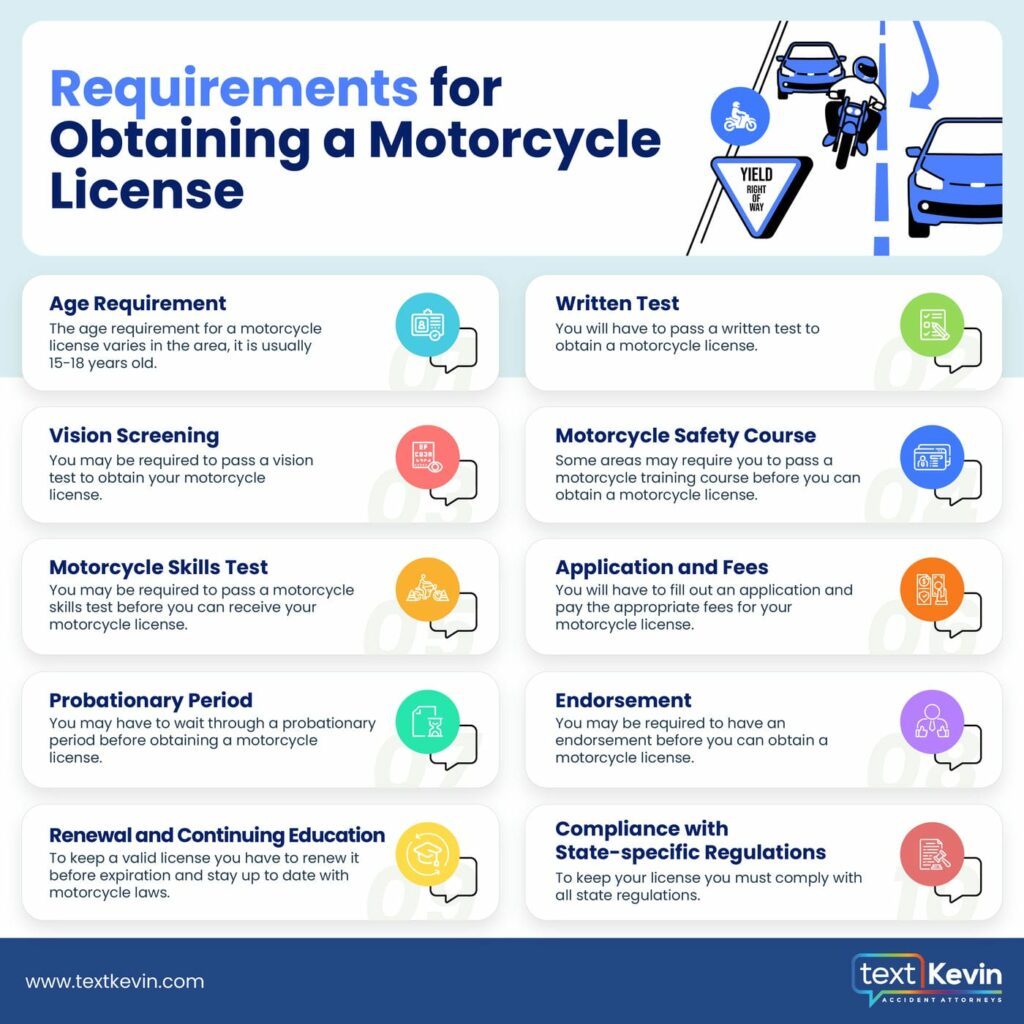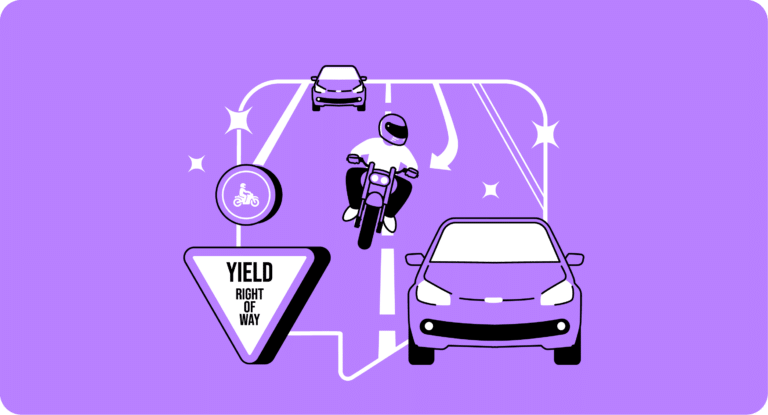Understanding the right of way for motorcycles is crucial for ensuring safety on the roads.
By grasping these rules, motorcyclists and other drivers can contribute to a safer, more predictable road environment, reducing the risk of accidents and misunderstandings.
Factoid About US Motorcycle Fatalities
| Statistic | Value | Description |
|---|---|---|
| Percentage of Motorcycles (Registered Vehicles) | 3% | Motorcycles make up 3% of all registered vehicles. |
| Traffic Fatalities (2021) | 14% | Motorcyclists accounted for 14% of all traffic fatalities. |
| Occupant Fatalities (2021) | 17% | Motorcyclists constituted 17% of all occupant fatalities. |
| Occupant Injuries (2021) | 3% | Motorcyclists accounted for 3% of all occupant injuries. |
| Fatality Increase (2020-2021) | 8% | Fatalities among motorcycle riders and passengers increased by 8%. |
| Nonfatal Injuries Increase (2020-2021) | 5% | Nonfatal motorcycle injuries increased by 5%. |
| Registered Motorcycles Increase (2007-2021) | 38% | Registered motorcycles increased by 38%. |
| Majority of Fatalities (2021) | Urban Roads (67%) | Most motorcyclist fatalities occurred on urban roads. |
| Helmet Usage (Fatalities, 2021) | 59% | 59% of motorcyclists who died were wearing helmets. |
What is the Right of Way for Motorcycles?
Motorcycles, like all vehicles, must adhere to specific traffic rules to ensure safety. The right of way for motorcycles is a set of guidelines that determines who has the priority in various traffic situations.
Knowing these rules helps prevent accidents and ensures a smoother flow of traffic. It’s not just about who goes first—it’s about understanding and anticipating the actions of others to maintain safety and order on the roads.
Importance of Understanding Traffic Laws for Motorcyclists
For motorcyclists, knowing when they have the right of way can be the difference between a safe ride and a potential accident.
It’s essential for motorcyclists to understand traffic laws to protect themselves and others on the road. This knowledge not only helps in avoiding collisions but also in fostering a sense of responsibility and awareness among motorcyclists, contributing to overall road safety.
Common Misconceptions About Motorcycles in Traffic
Many drivers assume motorcycles can maneuver quickly and stop faster than cars, leading to misconceptions about their right of way. Clearing up these misconceptions is vital for mutual respect and safety on the roads.
Motorcycles, despite their agility, are subject to the same rules as other vehicles, and understanding this helps in preventing dangerous assumptions and actions in traffic.
The Impact of Right of Way on Motorcycle Safety
When motorcyclists and other drivers know and respect right of way rules, the likelihood of collisions decreases significantly. This knowledge is a key factor in reducing accidents and enhancing road safety.
By ensuring that all road users are aware of and adhere to these rules, we can create a safer environment for everyone, especially for motorcyclists who are more vulnerable in accidents.
Legal Framework Governing Motorcycle Traffic
The legal framework for motorcycle traffic includes state and federal laws that outline right of way rules. These laws ensure that all road users know who has the right to proceed first in different traffic scenarios.
Understanding and complying with these laws is crucial for all road users, as they provide the basis for orderly and predictable traffic flow, reducing the chances of conflicts and accidents.
Understanding Motorcycle Licensing and Regulations
Obtaining a motorcycle license is a critical step for any rider, ensuring they have the necessary skills and knowledge to operate a motorcycle safely. This section explores the requirements and regulations surrounding motorcycle licensing, emphasizing its importance in promoting road safety.
Requirements for Obtaining a Motorcycle License
Obtaining a motorcycle license is a critical step in ensuring that riders have the necessary skills and knowledge to safely operate their vehicles on public roads. The process is designed to prepare individuals for the unique challenges of motorcycle riding.
Here are the key steps involved in obtaining a motorcycle license:
- Age Requirement
- Written Test
- Vision Screening
- Motorcycle Training Course
- Skills Test
- Application and Fees
- Probationary Period
- Endorsement
- Renewal and Continuing Education
- Compliance with State-Specific Regulations
By following these steps, aspiring motorcyclists can obtain their license, ensuring they are legally and adequately prepared to enjoy the freedom and responsibilities of motorcycle riding.
Age Requirements and Education Courses for Motorcyclists
The age at which one can obtain a motorcycle license varies by state, but it generally ranges from 15 to 18 years old.
Many states require young riders to complete a motorcycle education course, which provides valuable hands-on experience and safety training. These courses are crucial for developing responsible riding habits early on.
The Significance of a Valid Motorcycle License
Having a valid motorcycle license is essential for legal and safety reasons. It certifies that the rider has met specific standards of knowledge and skill.
Moreover, it’s often a requirement for insurance purposes. Riding without a valid license can lead to severe legal consequences and increased risks on the road.
The Role of Licensing in Promoting Road Safety
The licensing process plays a crucial role in promoting road safety by ensuring that motorcyclists are prepared and knowledgeable. It reduces the likelihood of accidents caused by inexperienced or untrained riders.
A well-informed motorcyclist is more likely to make safe decisions on the road, contributing to the overall safety of all road users.

General Traffic Laws for Motorcyclists
Motorcyclists are required to follow the same traffic laws as other motorists, but there are also specific regulations that apply only to them. Understanding these laws is crucial for safe riding and legal compliance.
Compliance with Standard Traffic Laws
Just like drivers of cars and trucks, motorcyclists must obey all standard traffic laws, including speed limits, traffic signals, and signs. These laws are designed to ensure the safety and efficiency of all road users.
Motorcyclists, due to their vehicle’s unique characteristics, must be especially vigilant in following these rules to avoid accidents.
Specific Rules for Motorcycle Operation on Roads
Motorcycles have specific operational rules, such as requirements for daytime running lights and the prohibition of lane splitting in many states. These rules take into account the motorcycle’s size, maneuverability, and visibility, aiming to reduce the risk of accidents.
Adhering to these specific regulations is essential for safe motorcycle operation.
Passenger and Cargo Restrictions for Motorcycles
There are laws regarding carrying passengers and cargo on motorcycles. For instance, the motorcycle must be equipped with a dedicated passenger seat and footrests if carrying a passenger.
Cargo should be securely fastened and not interfere with the motorcycle’s operation. These rules ensure that the additional weight does not compromise the motorcycle’s stability and safety.
Mandatory Use of Protective Gear and Eyewear
Many states have laws mandating the use of helmets, and some extend these requirements to protective eyewear. Even in states where helmets are not compulsory for all riders, they are highly recommended.
Helmets and protective gear significantly reduce the risk of serious injury in the event of an accident.
Legal Implications of Helmet and Eyewear Regulations
Failure to comply with helmet and eyewear regulations can result in fines and penalties.
More importantly, it can increase the severity of injuries in a crash. Understanding and adhering to these laws is crucial for personal safety and legal compliance.
Riders should always check the specific requirements in their state and wear appropriate protective gear, regardless of the legal mandate.
Right of Way Rules for Motorcycles
Understanding when motorcycles have the right of way is crucial for all road users to prevent accidents and ensure smooth traffic flow. This section explains the specific conditions under which motorcycles have the right of way and how these rules align with general traffic laws to safeguard motorcyclists and other drivers.
Conditions Under Which Motorcycles Have the Right of Way
Understanding when motorcycles have the right of way is a fundamental aspect of road safety that benefits all users. Motorcycles, often less visible than cars, require particular attention to ensure their riders’ safety.
Here’s a concise list highlighting these conditions:
- Motorcycles have the right of way at stop signs when they arrive first, similar to any other vehicle.
- At uncontrolled intersections, motorcycles should be given the right of way if they are on the main road and cars are entering from a secondary road.
- When traffic lights turn green, motorcycles have the right of way to proceed straight or make allowed turns.
- In cases where motorcycles and cars arrive at an intersection simultaneously, the vehicle to the right has the right of way.
- Motorcycles have the right of way on highways unless merging or exiting, where standard yielding rules apply.
- During lane changes, if a motorcycle is in the lane, other vehicles must yield the right of way before merging.
- In roundabouts, motorcycles within the circle have the right of way over vehicles entering.
- Emergency situations grant motorcycles the right of way when they need to maneuver to avoid hazards.
- When a motorcycle is in a designated lane, such as a bike lane or HOV lane, it has the right of way within that lane.
- At pedestrian crosswalks, motorcycles must yield to pedestrians but have the right of way over cars waiting to turn.
Comparing Motorcycle and Car Right of Way Scenarios
It’s essential to understand how right of way rules apply to motorcycles compared to cars.
For instance, at a four-way stop, the vehicle that arrives first proceeds first, regardless of whether it’s a motorcycle or a car.
Such knowledge ensures that all motorists respect each other’s right of way, reducing the risk of collisions.
Intersections and Right of Way for Motorcycles
Intersections are common points of confusion and conflict for right of way.
Motorcycles, due to their smaller size, might be overlooked, but they have the same rights at intersections as any other vehicle.
If a motorcycle reaches an intersection simultaneously with a car, the vehicle on the right should proceed first, following the standard right of way protocol.
The Impact of Traffic Signals on Motorcycle Right of Way
Traffic signals dictate the right of way, and motorcycles must adhere to these signals just like any other vehicle.
When a traffic light turns green, motorcycles can proceed straight or turn right, but they must yield to oncoming traffic when turning left, unless they have a dedicated turn signal.
Legal Consequences of Failing to Yield the Right of Way
Failing to yield the right of way can lead to traffic citations and fines. More critically, it can result in accidents that cause injury or property damage.
Understanding and respecting right of way rules is essential for legal compliance and the safety of all road users, including motorcyclists.
Need Legal Support? Contact Kevin Accident Attorneys
If you’re a motorcyclist seeking legal advice or representation, Crockett Law Group are here to assist you.
As experienced motorcycle accident lawyers in Anaheim, they understand the complexities of motorcycle laws and can provide the guidance and support you need.
Don’t hesitate to reach out at (800) 900-9393 for expert legal assistance tailored to your situation.










